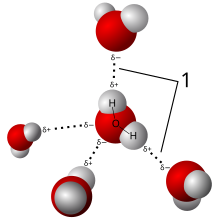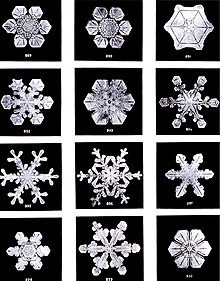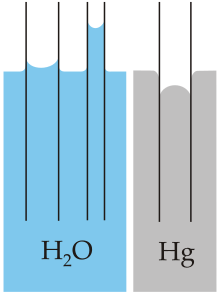Water is the chemical substance with chemical formula H2O: one molecule of water has two hydrogen atoms covalently bondedto a single oxygen atom.
Water appears in nature in all three common states of matter and may take many different forms on Earth: water vapor and clouds in the sky; seawater and icebergs in the polar oceans; glaciers and rivers in the mountains; and the liquid in aquifers in the ground.
At high temperatures and pressures, such as in the interior of giant planets, it is argued that water exists as ionic water in which the molecules break down into a soup of hydrogen and oxygen ions, and at even higher pressures as superionic water in which the oxygen crystallises but the hydrogen ions float around freely within the oxygen lattice.
The major chemical and physical properties of water are:
- Water is a liquid at standard temperature and pressure. It is tasteless and odorless. The intrinsic color of water and ice is a very slight blue hue, although both appear colorless in small quantities. Water vapor is essentially invisible as a gas.
- Water is transparent in the visible electromagnetic spectrum. Thus aquatic plants can live in water because sunlight can reach them. Ultra-violet and infrared light is strongly absorbed.
- Since the water molecule is not linear and the oxygen atom has a higher electronegativity than hydrogen atoms, it carries a slight negative charge, whereas the hydrogen atoms are slightly positive. As a result, water is a polar molecule with an electrical dipole moment. Water also can form an unusually large number of intermolecular hydrogen bonds (four) for a molecule of its size. These factors lead to strong attractive forces between molecules of water, giving rise to water's high surface tension and capillary forces. The capillary action refers to the tendency of water to move up a narrow tube against the force ofgravity. This property is relied upon by all vascular plants, such as trees.
- Water is a good solvent and is often referred to as the universal solvent. Substances that dissolve in water, e.g., salts, sugars, acids, alkalis, and some gases – especially oxygen, carbon dioxide (carbonation) are known as hydrophilic (water-loving) substances, while those that do not mix well with water (e.g.,fats and oils), are known as hydrophobic (water-fearing) substances.
- All the major components in cells (proteins, DNA and polysaccharides) are also dissolved in water.
- Pure water has a low electrical conductivity, but this increases significantly with the dissolution of a small amount of ionic material such as sodium chloride.
- The boiling point of water (and all other liquids) is dependent on the barometric pressure. For example, on the top of Mt. Everest water boils at 68 °C (154 °F), compared to 100 °C (212 °F) at sea level. Conversely, water deep in the ocean near geothermal vents can reach temperatures of hundreds of degrees and remain liquid.
- At 4181.3 J/(kg·K), water has the second highest specific heat capacity of any known substance (after ammonia), as well as a high heat of vaporization(40.65 kJ·mol−1), both of which are a result of the extensive hydrogen bonding between its molecules. These two unusual properties allow water to moderate Earth'sclimate by buffering large fluctuations in temperature.
- The maximum density of water occurs at 3.98 °C (39.16 °F). It has the anomalous property of becoming less dense, not more, when it is cooled down to its solid form, ice. It expands to occupy 9% greater volume in this solid state, which accounts for the fact of ice floating on liquid water.
- Its Density is 1,000 kg/m3 liquid (4 °C), and weighs 62.4 lb/ft.3 (917 kg/m3, solid). It weighs 8.3454 lb/gal. (US, liquid)
- Water is miscible with many liquids, such as ethanol, in all proportions, forming a single homogeneous liquid. On the other hand, water and most oils are immiscible usually forming layers according to increasing density from the top. As a gas, water vapor is completely miscible with air.
- Water forms an azeotrope with many other solvents.
- Water can be split by electrolysis into hydrogen and oxygen.
- As an oxide of hydrogen, water is formed when hydrogen or hydrogen-containing compounds burn or react with oxygen or oxygen-containing compounds. Water is not a fuel, it is an end-product of the combustion of hydrogen. The energy required to split water into hydrogen and oxygen by electrolysis or any other means is greater than the energy that can be collected when the hydrogen and oxygen recombine.
- Elements which are more electropositive than hydrogen such as lithium, sodium, calcium, potassium and caesium displace hydrogen from water, forming hydroxides. Being a flammable gas, the hydrogen given off is dangerous and the reaction of water with the more electropositive of these elements may be violently explosive.






No comments:
Post a Comment